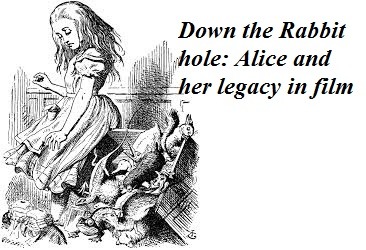
SPOILERS FOR SPIRITED AWAY
Please note: This review was made in reference to the original Japanese version with English subtitles. As such, minor details and names may differ.

Chihiro’s adventures in relation to the down the Rabbit Hole trope.
Quite simply, Spirited Away is a film that lives and breaths the down the rabbit hole trope. Albeit one that mixes a distinctly Japanese flavour and folklore with a more western Alice style narrative. It perfectly fits the archetype in various ways. Unlike the last film I looked at for this project, Valerie and her Week of Wonders, Spirited Away doesn’t present any subversions or inversions. It plays the archetype straight. As a coming of age story it also fits the type perfectly, as Chihiro’s resilience and maturity grows the more she gets used to her encounters in the spirit World. In this sense, Chihiro is different from many other heroines of these films because she changes other time. This is comparable with another character of this genre, Coraline.
Chihiro, Alice, and Identity.
Like Carroll’s Alice, Chihiro’s sense of identity is weakened once she has crossed over into the Spirit World. Working for the witch Yubaba, the first thing she is tasked to do is to sign her name away, leaving her with the alternate name Sen. In a later talk with Haku he gives her a namecard with Chihiro written on it, although by this point she has already begun to forget her name. Haku cannot return to his real form as he cannot remember his real name and it is hinted at that this is how Yubaba controls people.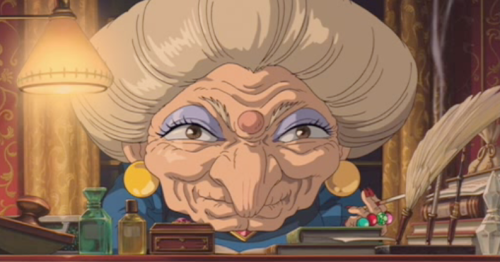
Alice faces a comparable crisis when she mistakes herself for her classmates after her fall into Wonderland, and her attempts at recovering her identity via recitation of poems she learnt in the schoolroom fail. it is not until a later chapter when she re-establishes her identity.
`I’m sure those are not the right words,’ said poor Alice, and her eyes filled with tears again as she went on, `I must be Mabel after all, and I shall have to go and live in that poky little house, and have next to no toys to play with, and oh! ever so many lessons to learn! No, I’ve made up my mind about it; if I’m Mabel, I’ll stay down here! It’ll be no use their putting their heads down and saying “Come up again, dear!” I shall only look up and say “Who am I then? Tell me that first, and then, if I like being that person, I’ll come up: if not, I’ll stay down here till I’m somebody else”
Pigs, metamorphosis and character

At the very beginning of Chihiro’s adventures her parents, concerned with themselves only, eat the food of the spirits and later metamorphose into pigs, a symbol of their gluttony. The other creatures that Chihiro encounters also transform. Zeniba, Yubaba’s sister, turns Yubaba’s son into a mouse. No face, the shadow-like spirit, punishes the bathouse workers for greed by eating their personalities as well as literally eating them.
In Alice’s dreamworlds, events often melt together. In the Looking-Glass World, one minute Alice is in a shop, the next she is rowing a boat down a river.
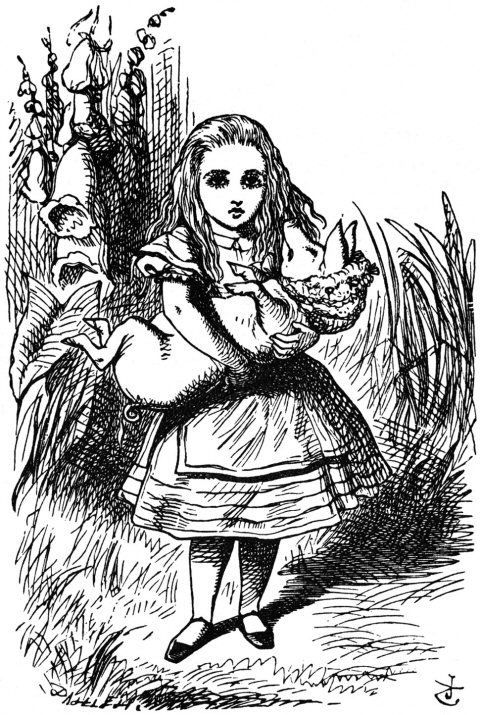
In terms of metamorphosis, the Duchess’s baby in Wonderland turns into a pig when Alice holds it:
`If you’re going to turn into a pig, my dear,’ said Alice, seriously, `I’ll have nothing more to do with you. Mind now!’ The poor little thing sobbed again (or grunted, it was impossible to say which), and they went on for some while in silence.
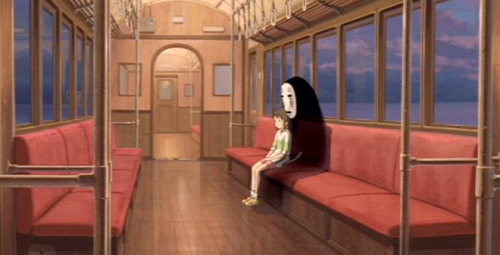
Train Rides
Perhaps the most iconic or familiar scene in Spirited Away is when No Face, Chihiro. and two transformed creatures board a train. The passengers are shadows, and the train stops are full of slightly surreal locations. Chihiro gazes out of the window in wonder, before the train reaches Zeniba’s house.
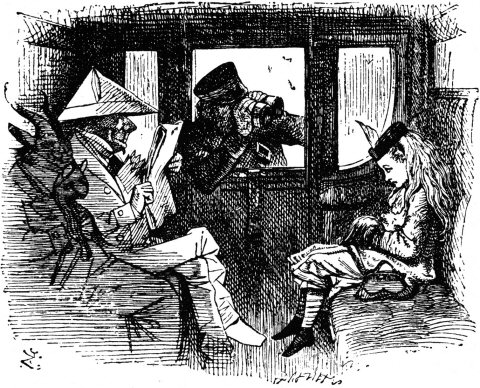
This quiet scene is in wild contrast to the train journey in the Looking Glass World which Carroll’s Alice faces in Through the Looking-Glass.
First of all, whilst the passenger’s in Chihiro’s journey never speak, Alice finds herself on a train where people never seem to shut up.
And after that other voices went on (‘What a number of people there are in the carriage!’ thought Alice), saying, `She must go by post, as she’s got a head on her – ’ `She must be sent as a message by the telegraph – ’ `She must draw the train herself the rest of the way – ’ and so on.The atmosphere is chaotic and uncertain. But what links this scene to Spirited Away is the oddness of the people and animals that Alice sees. Chihiro sees shadow like people, a conductor with no face and her bizarre travelling companions. Alice sees a downright surreal revolving door cast of passengers, a train Ticketmaster who looks at her upside down, a Gnat, a Goat, a horse, and even a man in a paper suit.

Tea
Chihiro takes tea at Zeniba’s house whilst Alice famously has tea with the hatter, Hare and dormouse in Wonderland. Chihiro listens to Zeniba reveal to her the secret of her seal, and Alice desperately wants to understand the meaning of the tale the Dormouse tells. However in true Wonderland fashion, Alice, unlike Chihiro, doesn't get her answer.
They were learning to draw,’ the Dormouse went on, yawning and rubbing its eyes, for it was getting very sleepy; `and they drew all manner of things—everything that begins with an M—’
`Why with an M?’ said Alice.
`Why not?’ said the March Hare.
Alice was silent.